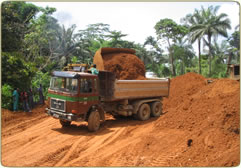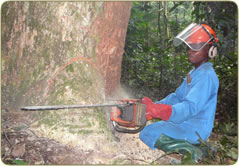Reduced impact logging is composed of measures which diminish negative effects, for humans and the environment, of logging operations.
Developed based on the “Regional Code of practice for reduced impact forest harvesting - in tropical moist forests of West and Central Africa” (FAO 2003), they have been adapted for the Congo and are the subject of an Operations Guide that specifically covers these techniques.
SODEFOR has entirely adopted them, and they are currently implemented throughout all of its concessions and activities.
Exclusion Zones
Certain zones within the production areas and adjoining zones are less appropriate for logging than others. In order to protect them, they must be excluded from logging. This allows us to reduce impacts on populations, resources, and the environment.
The zones to be excluded are:
Les zones à exclure sont :
- Non-operational zones: swamps, steep slopes (30% slopes or greater), and rocky zones;
- Zones of cultural or religious importance: sacred trees or forests;
- Zones of ecological, scientific, or tourist value: zones of very high flora or fauna diversity, endemic species habitats, unique or fragile habitats, etc.;
- Sensitive zones, meaning zones bordering permanent waterways, backwaters, or around swamps. Minimum width of sensitive zones:
| 1. Width < 10m | 50 m on each side of the river |
| 2. Ravines | 10 m on each side |
| 3. Streams or backwaters | 20 m on each side |
| 4. Swamps | 10 m from the border |
| 5. Headspring | 150 m around |
Protected Trees
Trees that are protected during exploitation are classified into 3 categories:
1. Crop trees: these are the trees that will reconstitute the available volume after one rotation. Consequently, they must be protected so that the volume can be reconstituted. These trees will be marked with Ø.
2. Heritage trees: social studies carried out during the development of the Management Plan will identify possible heritage trees. These trees have important social value and must be protected. These trees will be marked with “P”.
3. Seed-bearers from the total amount of saplings numbered when counting the available species, we will subtract certain trees that will serve as seed-bearers. They will also be numbered, but will be marked with “S” during tracking.
Road network and log yards
The road network and log yards ensure the evacuation of the forest resources.
They are indispensable but have significant direct and indirect impacts. We are planning and optimizing this network of skid trails and log yards as follows:
- By avoiding zones without much wood;
- By circumventing areas with steep slopes, swamps, or which are ecologically sensitive, etc.
- By limiting the surface area of log yards as much as possible;
- By adhering to a maximum of 30m of deforestation for their roads and their allowances;

- By maintaining canopy bridges at least every 5 kilometers, and opening the windrows
- By building and maintaining drainage structures to collect and evacuate water
- By avoiding disturbances to rivers and waterways;
- By preserving both crop trees and heritage trees during planning.


To build these roads we use:
. Caterpillar bulldozers for opening the roads,

. Loaders to load laterite into trucks

. Dump trucks to bring laterite in order to refill the roads

. Excavators to dig ditches and drains
. Levelers to level the roadway

. Compactors to pack the soil.
Controlled Harvest
Harvesting is an essential operation in logging. It must be done securely, while preserving the maximum amount of crop saplings which could be damaged when a tree falls. To do this, every year since October 2005 we have carried out trainings. The technique taught during these trainings and which is now in force can be broken out into the following steps:
- Determine the direction in which the tree will fall using precise analysis of the tree’s asymmetrical areas;

- Identify compression and tension zones in order for felling to focus on compression zones;
- Clean the shaft at the felling height (remove termite mounds, vines...) and clear a pathway in the felling ground.


- Fell the tree from as low as possible for trees without significant buttress roots.

- If necessary, trim these down (remove buttress roots which impede cutting);

- Perform a sufficient directional cut: a depth of 1/5 to 1/3 of the trunk’s diameter;

- Perform a felling cut (except for small trees of less than 40cm in diameter when clearing a road) or a mortise cut for large trees;

- Create an appropriate hinge;

- Remove holding wood to cause the tree to fall.


Clearing and skidding
Clearing and skidding are the first steps in transporting wood to the log yard, or more precisely from the felling site to the loading area. The impact of these two steps are always very negative and cause damage to the ground and the remaining population. These inevitable impacts have been reduced, however:
- By plotting the optimal skidding path for the logs (the straightest and least wide) while avoiding too tight bends;
- By avoiding protected trees;
- By crossing as few waterways as possible, and if this is impossible, taking precautions (log bed, perpendicular to the bank, passing over a rocky bed, etc.);
- By limiting the use of bulldozers in clearing or prolonged clearing, including choosing other methods of extraction in case of steep slopes;
- By using winches and cables for skidding, if the log’s size and weight allow it.
Post-logging operations
In order to leave production areas in a state that facilitates their regeneration and to avoid any additional damage to the environment, we perform certain operations after logging;
- Restoring skidding paths and logyards;
- Removing all processing debris or obstacles to free water flow in riverbank protection areas;
- Closing roads that will not be used again before the second rotation (the time lapse during which we let the forest regenerate, or 25 years). Closing roads can be done using logs, digging ditches, or by installing locked barriers.
